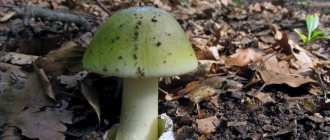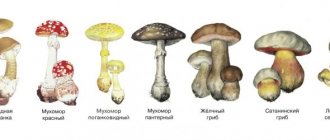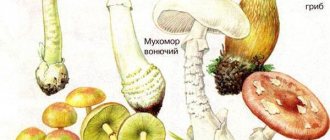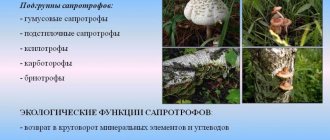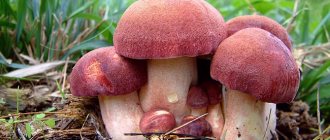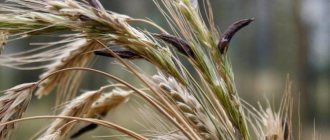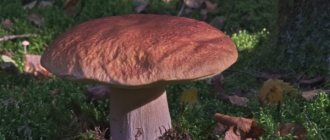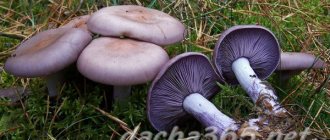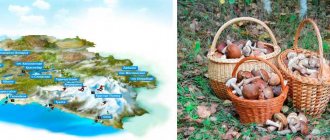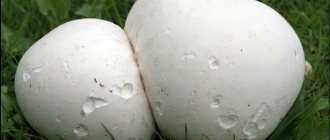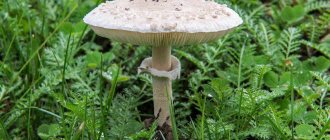The most dangerous and “popular” mushrooms include almost all types of fly agarics and toadstool. They can disrupt the functioning of the gastrointestinal tract, cardiovascular and nervous systems, and completely affect the brain. And no heat treatment will help neutralize the deadly poisons contained in these mushrooms. However, there are other poisonous mushrooms that are no less dangerous. This article will introduce you to such mushrooms.
The most common poisonous mushrooms
“The meat of the earth,” as mushrooms are sometimes called, truly has a unique taste, which attracts lovers of quiet hunting to look for mushroom places again and again. Experienced “hunters” of nature’s delicacy are well aware that the most common and dangerous poisonous ones include the following :
- pale grebe;
- stinking fly agaric;
- panther fly agaric;
- false value;
- satanic mushroom;
- sulfur-yellow false fungus.
It is important to know about the existence of conditionally edible drugs that act selectively on the body in accordance with the circumstances. In the worst case, such mushrooms can cause moderate and moderately severe poisoning. These include:
- violin (felt breast);
- rowing (some species are conditionally edible, while others are poisonous);
- wave;
- pig, etc.
This category of mushrooms contains poisonous resins that have a detrimental effect on the digestive system. Appropriate treatment can play the role of an antidote: long-term soaking in water, which needs to be changed periodically, salting and standing for at least 1.5 months. But in some cases this may not be enough.
But, for example, false chanterelles are considered edible in some countries (and even among mushroom pickers in Russia there are such beliefs), but with the caveat that they cause an allucinogenic effect, as well as digestive upset.
We do not recommend eating (or even touching) mushrooms that are of questionable safety, not to mention really dangerous (poisonous) mushrooms.
Signs of edible porcini mushrooms
Beginning lovers of quiet hunting are often interested in the question: what is the difference between an edible porcini mushroom and poisonous varieties?
They have several differences:
- The tubular layer (sponge) can only be painted white, yellowish or olive. Any other shades indicate that the mushroom found is false. For example, in edible bitterling, the tubular layer has a pronounced pinkish tint.
- The pulp is dense, has no taste, and most often there is no smell, or there are light mushroom or nutty notes in it. Contrary to popular belief, the flesh of some varieties may turn blue after being cut. A striking example is edible Polish.
- Insects and animals living in the forest love boletus mushrooms more than other forest gifts. Therefore, large specimens are often bitten and their legs are worm-eaten. Collecting fruiting bodies affected by larvae is not recommended. The waste products of these insects can cause serious eating disorders.
When going into the forest, you need to remember the main rule of the mushroom picker. If you are not sure of the edibility of the found specimen, it is better to avoid it altogether.
Characteristic signs of poisonous mushrooms
Neither in the world of animals nor plants do there exist “doubles” with similar external characteristics, but completely different in character. But this is exactly what happens with mushrooms. For example, the same species is divided into harmless and poisonous, and it is very difficult to distinguish them if you do not know the main false signs.
Each type of poisonous mushroom growing in Russia has its own characteristics, which should be known to those who are not ready to exclude independently collected mushrooms from their diet. In order not to make a fatal mistake, you need to study in detail and remember the description of mushrooms harmful to health and life.
Carefully consider the appearance of the mushroom, the color of the cap and plates, the shape of the stem, the condition of the pulp when cut - the main rule.
Rules, gathering places and precautions
The first thing that is important to pay attention to when hunting for edible mushrooms is the collection location. An excellent option for harvesting would be the forest or mountains. The main condition is to be away from dusty roads and industrial zones.
If children are present during the hunt, they should be strictly prohibited from touching or tasting berries and mushrooms. A wicker basket or knapsack is considered a suitable container for forest gifts, in which the fruits will “breathe” fresh air.
It is advisable to go for mushrooms early in the morning. It is advised not to pull the fruiting body out of the soil; it is better to cut it off or carefully unscrew it in order to cause minimal harm to the mycelium. If the damage is severe, the mycelium dies, which means that there will be no new mushrooms in this place. Before placing the fruiting body in the basket, it is carefully inspected for worms.
At home, the harvest should be carefully inspected again, washed, cleaned and processed properly. After boiling the fruits, the water must be poured out, because it contains harmful or even toxic substances.
Remember!
If, when picking mushrooms, even the slightest doubt arises regarding the edibility of a particular representative, then it is better to leave it in the forest.
Toadstool pale
This is the most famous poisonous mushroom in the world; it has a second name - green fly agaric. Appears from mid-summer to late autumn, can grow in groups or alone. Loves pine and deciduous forests, especially at the edges. It is found in Russia, in many European countries and even in America.
At the first stage of development, the cap looks like a bell, then it becomes convex. Its surface attracts with its velvety and perfect smoothness. The diameter of the cap is 4-11 cm. The under-hat plates and stem are white.
To distinguish it from an edible mushroom, you need to be extremely careful. The pale grebe is first covered with a solid white film. Then, over time, it is rejected and a rim is formed around the leg, and there is also a basal sheath in the form of a sac-like thickening.
The danger of toadstool is not only the presence of deadly toxins, but also the fact that it is extremely similar to everyone’s favorite champignons or russula. Populations of both are observed in similar places; they have the same color and stem shape as edible mushrooms.
And, unfortunately, they are often confused, dooming oneself to severe poisoning, after which not everyone manages to get out alive. After all, the poisons contained in toadstool are heat-resistant and dissolve in water without losing their destructive properties. It is enough to consume 50 g of toadstools, and death is guaranteed.
There is a type of toadstool that is exactly like a champignon. It has a pure white color, which makes it interesting. But if you take a closer look, it will become clear that this is another trick of these half-living, half-plant creatures. The plates under the cap are the same white and merge with the whiteness of the mushroom. In champignons, they are pinkish at first, and darken during ripening.
There are medications that can eliminate the effects of the strongest toxins contained in toadstool. But, unfortunately, the symptoms of poisoning by this fungus are hidden for a long time (up to 2 days), which most often becomes the cause of death when precious time is lost to save the victim.
Pale toadstool does not have the usual mushroom aroma. It is not for nothing that they call it smelly.
What mushrooms are similar to porcini mushrooms?
Boletuses are a large group of mushrooms, including many varieties. They are all similar in appearance, but there are some differences.
Reference! Very often the Polish mushroom is confused with boletus. It looks like white, but turns blue when broken and when pressed. A change in the color of the pulp is not a reason to reject the find. Polish ones are very tasty and suitable for any type of processing. They are tasty fried and salted, and are suitable for drying and freezing. Small fruiting bodies can be pickled.
Among the edible varieties of boletus are:
- Birch: a species with a hemispherical cap that opens with age. The skin is light yellow or almost white. The tubular layer is initially white, but becomes yellowish with age. The leg is cylindrical, light brown. It is found not only in birch groves, but also in mixed, and less commonly, coniferous forests. Often grows along clearings and forest roads.
- Oak: valuable edible species. Its pleasant rich aroma remains even after drying. The cap is large, up to 30 cm in diameter, colored in different shades of brown. The leg is light and thick, the tubular layer under the cap is white in young specimens, and light yellow in old specimens.
- Pine: The variety with the brightest color. Adult fruiting bodies have a wine-red cap, and the sponge under the cap is greenish. It is found mainly in well-lit clearings of coniferous forests, but sometimes it also grows under the crowns of deciduous trees.
A representative of any variety of boletus is a real hero among mushrooms. Large specimens are distinguished by a wide cap and a thick stem, by which boletus mushrooms are often recognized.
Satanic mushroom
This giant looks very similar to a white mushroom or oak mushroom, and is just as attractive. Often found in oak or mixed forests of Russia. It can be found in the middle zone and European countries. The period of active growth occurs from June to September.
The hat of this “monster” can reach 25-30 cm, its color is gray or with an olive tint. The leg with a mesh pattern gradually changes its shade - at first it is yellow, then becomes yellow-red. Its height is from 5 to 15 cm, thickness – up to 10 cm.
The plates under the cap also change color depending on the stage of development of the fungus: first greenish, then yellow, orange, red, brown-red.
If the satanic mushroom is cut, the white flesh will first turn pink, then turn blue. A cut young mushroom smells like rotten onions, a mature one smells like carrion.
Pepper mushroom
pepper
mushroom should also be considered inedible mushrooms . It looks like a small oil can or flywheel. But if you look closely, you will find obvious differences. The pepper mushroom has a convex cap that is brown or reddish in color. The spore-bearing layer is tubular, yellowish-red or brown in color (in boletus - white or light yellow, in moss - yellowish-greenish).
The flesh of the pepper mushroom is yellowish, sometimes turning red at the break (in the oiler it is white, in the moss mushroom it turns blue). And finally, the taste of the pepper mushroom, as you can easily guess from its name, is hot, bitter, peppery. Although black pepper may seem like a delicacy in comparison. Pepper mushroom grows singly, in the same places where boletus mushrooms grow.
By carefully reading the description of poisonous mushrooms, mushroom pickers will protect themselves from the danger of confusing them with good edible mushrooms.
Rating: 4.5/5 — 15 votes
fly agaric
A more attractive mushroom than the red fly agaric can hardly be found. During ripening, white flakes form on the surface of the cap. It is the red hat with white polka dots that is the main attracting factor. This mushroom, with its attractive colors and shape, often causes fatal consequences for ignorant mushroom pickers, and especially children.
Its habitat is not limited to the territory of Russia; it grows with equal success in European, Asian countries and even in Australia.
It is important to know that this mushroom has different colors: from white, greenish, gray to bright red. After all, there are many types of mushrooms of the Amanita genus. And most of them are deadly.
The stinking fly agaric is the most poisonous of all its brothers. It doesn't look as nice and looks like a toadstool. It has a cone-shaped yellowish cap. When cut, it emits a foul odor. People often used it as a remedy for harmful insects. Traditional healers used medicines based on fly agaric in the treatment of nervous diseases.
Amanita stinking
"Scary" mushrooms
It seems that the bloody tooth is the most creepy and poisonous representative of the mushroom kingdom. But is it? There are at least three more species that can compete for this title.
The main contender for the title of creepiest is Archer's Clatus. It is also called devil's fingers or stinking octopus horn. It looks like the tentacles of a cephalopod that "hatch" from an egg - an early stage of maturation. It got its name for a reason - it has a disgusting smell. Although it is edible, only the bravest daredevils dare to try it. Most often they grow in Australia and Tasmania. They reproduce by spores carried by flies attracted by the pungent odor.
Another, no less disgusting-looking mushroom is a line called the “brain mushroom.” The name speaks for itself. Visually resembles the brain or kernels of a walnut. It is often confused with morels, but the latter, unlike it, are edible. In their raw form, stitches are poisonous and harmful to the body. Opinions differ regarding the preparation of mushrooms and the removal of toxic elements from it, so eating and cooking this type of mushroom is not recommended in order to avoid problems with the gastrointestinal tract. They grow in pine and spruce forests. From them, like from a bloody tooth, you can make an alcohol tincture. This mixture helps with joint pain, coughing, and is used to rub the back. Internal use of the liquid is contraindicated for health reasons.
In last place is a mushroom called Askokorine meat. He received this name for his appearance. During the growth process, the mushrooms unite, forming one continuous mass similar in color to pieces of meat or minced meat. Their color varies from lilac-violet to meat-red shades, and the pulp is a solid jelly-like mass. This species is widespread in Europe and North America. They mainly live in trees in large groups. It is not edible, but has a number of useful properties discovered by scientists during the study process. Ascocorine meat releases volatile substances, which consist of carbon alcohol, octane and ketone. They form a mixture vaguely similar to automobile fuel.
An inedible mushroom does not mean useless. Some are more beneficial when they are made into decoctions or tinctures, dried, added to ointments, or beneficial substances are isolated from them in the laboratory. Even if the mushroom seems poisonous and repulsive, you should not trample it right away. It can be useful, if not to humans, then to wild animals, which often use mushrooms and plants for self-medication.
Patouillard fiberglass
It grows in entire families and is a representative of agaric fungi. It appears in coniferous and deciduous forests, as well as in parks and artificial forest belts already in early May and maintains its populations until August. It is found in both Asia and Europe.
When young, it has a white cone-shaped cap and can easily be confused with a champignon. With age it turns yellow and then turns red. The edge of the cap, whose diameter ranges from 3 to 9 cm, is wavy and cracks over time. The under-hat plates are thin, at first they are white, then darken and acquire a brown tint. The cylindrical stem of the mushroom is small in height - only 1.5 cm. It has a smooth surface and matches the color of the cap.
When cut, the white flesh turns slightly pink and attracts with a soft fruity aroma. An important feature: the entire mushroom is the same color, the stem at the bottom has a noticeable thickening.
What types of red mushrooms are there?
So, what are they, red-capped fungi, and is it worth adding them to your basket when going to the summer or autumn forest to collect the harvest? It is impossible to give a definite answer to this question, since each variety has individual properties, requiring more detailed study. And if we single out edible species, then these include:
- liverwort growing on tree trunks;
- swamp russula, which is not afraid of either drought or rain;
- The boletus lives mainly in deciduous forests.
Inedible representatives of the mushroom kingdom, the consumption of which is fraught with serious consequences for life and health, include the pungent russula and the poisonous fly agaric.
There is also a unique variety of red mushrooms called clathrus, popularly called lattice mushroom. Among the main features of this variety that feeds on rotten wood, it is worth highlighting its unusual structure, reminiscent of a blood-red holey bubble, as well as its rarity, which is why clathrus was listed in the Red Book, being on the verge of complete extinction.
Waxy talker
Grows in open areas covered with grass: meadows, parks, squares, forest edges. It can be found throughout Russia and many European countries. The dimensions of the mushroom are small: the maximum diameter of the cap is 6 cm. While the mushroom is young, it is convex, in a mature state it is concave. The white under-hat plates immediately darken when pressed. The leg is high, straight, slightly tapering towards the bottom.
The danger of this mushroom lies in its external attractiveness. It is difficult to recognize a poisonous mushroom in it; it has a rather pleasant smell and is white in color. However, it is necessary to remember the main distinguishing feature: the under-hat plates are fused to the leg.
This mushroom contains the toxin muscarine, which can affect the digestive organs, heart, and glands.
Taking into account the fact that the waxy govorushka at a young age is practically no different from the edible mushroom of the family Ryadovka, it is better not to touch it.
Mushrooms are edible and poisonous. Types and names of mushrooms with pictures
The best way to independently learn to recognize edible and inedible mushrooms is to familiarize yourself with their names, descriptions and photos. Of course, it is better if you walk through the forest several times with an experienced mushroom picker, or show your catch at home, but everyone needs to learn to distinguish between real and false mushrooms.
You will find the names of mushrooms in alphabetical order, their descriptions and photos in this article, which you can later use as a guide to mushroom growing.
Types and names of mushrooms with pictures
The species diversity of fungi is very wide, so there is a strict classification of these forest inhabitants (Figure 1).
So, according to edibility they are divided into:
- Edible (white, boletus, champignon, chanterelle, etc.);
- Conditionally edible (dubovik, greenfinch, veselka, milk mushroom, line);
- Poisonous (satanic, toadstool, fly agaric).
In addition, they are usually divided according to the type of bottom of the cap. According to this classification, they are tubular (outwardly reminiscent of a porous sponge) and lamellar (plates are clearly visible on the inside of the cap). The first group includes boletus, boletus, boletus and aspen. The second includes saffron milk caps, milk mushrooms, chanterelles, honey mushrooms and russula. Morels are considered a separate group, which includes morels and truffles.
Figure 1. Classification of edible varieties
It is also customary to separate them according to their nutritional value. According to this classification, they are of four types:
- With high taste qualities: saffron milk cap, milk mushroom and white;
- The second category: boletus, boletus, champignons and boletus.
- The third group is the most numerous and includes boletus, chanterelles, trumpets, russula and honey mushrooms.
- The fourth category includes species with the lowest taste: black milk mushrooms, ocher russula, goat and rubella.
Since there are so many types, we will give the names of the most popular ones with their pictures. The best edible mushrooms with photos and names are given in
Edible mushrooms: photos and names
Edible varieties include those that can be freely eaten fresh, dried and boiled. They have high taste qualities, and you can distinguish an edible specimen from an inedible one in the forest by the color and shape of the fruiting body, smell and some characteristic features.
Other poisonous mushrooms
The false valui differs from the edible one in that it does not have scars on the cap.
False Valui (aka Gebeloma sticky)
False honey fungus (especially sulfur yellow) are distinguished by a gray-yellow or greenish color on the inside of the cap, and there is no rim on the stem. They are also given off by an unpleasant odor, which is extremely far from mushroom.
The estimates are false
Poisonous rowers have difficult to recognize differences from conditionally edible and russula. The poisonous ones are equipped with a cone-shaped or flat cap, with a small sharp tubercle in the middle. The color of the cap ranges from smoky gray, green to bright yellow. If an incision is made, a pink color appears.
Poisonous rowers
The fringed galerina lives in coniferous forests, is very similar to the honey mushroom, but differs from it in the absence of a ring on the leg.
Bordered gallery
Description of dangerous mushrooms
It is important to know what poisonous mushrooms look like and to be able to distinguish them from the edible ones, which they often disguise themselves as.
Important! Photos in the table are clickable. Click to enlarge.
| Name | Description | Timing and area of growth | Similarity to edible and distinctive feature | Photo for distinction |
| Death cap | Hat: color yellow-brown, pale green, greenish-olive. The shape is flat or slightly rounded; in young ones it is ovoid. Under it there are white plates. The leg is long, widened towards the base, with a strong white ring on top. | Aug. Sept. Mixed, deciduous forests. Europe, Asia, North America, central Russia. | Champignon, greenfinch. The plates under the cap: the toadstool has only white ones; in champignon it is pink, darkening over time. | |
| Red fly agaric | Hat: bright red, maybe orange. The shape is flat in adults, round in small ones. There is a scattering of white growths on the surface, which is washed away by rain. The leg is long, white, fleshy, with a ring-shaped film at the top. | August - October Mixed forests, birch, spruce. The temperate climate of the Northern Hemisphere, Europe, Asia, Australia, is widespread throughout Russia. | Caesar's. Cap, leg and plates: Caesar's - smooth, yellow; in red - covered with white growths, white. | |
| White fly agaric | White color. The hat in young people is round, in adults it is half-open, up to 10 cm, with fine fringe at the edges. The leg looks like a fibrous cylinder, with a swollen base, and a wide ring at the top. Has the smell of bleach. | June August. Wet coniferous and deciduous forests. Warm temperate regions. | The float is gray. Ring and unpleasant smell: the fly agaric has it, the float does not. | |
| Galerina bordered | The cap and leg are yellow and brown; in juveniles there is a membranous ring. With age, the cap becomes flatter and darker. | June - October Coniferous forests. Northern Hemisphere, continental Asia, Australia, Caucasus. | Honey fungus autumn, summer. Galerina has a darker cap, without scales. | |
| Sulfur-yellow honey mushrooms | Caps: gray-yellow, reddish in the center. The shape is small (no more than 7 cm). The leg is light, smooth, fibrous. The color of the pulp is light yellow, the taste is bitter, and the smell is unpleasant. | June - October. Large groups on rotten wood. Eurasia, North America, throughout Russia. | Honey fungus autumn, winter, summer, gray-lamellar. Edible - there is a ring-shaped film on the stem, the plates under the cap are always light. Not edible - the plates are gray-yellow in color, darken over time, there is no film. | |
| Brick-red honey mushrooms | Hat: bright orange, brick red. The shape is hemispherical, then flat. Edges with whitish residual fibers. Leg up to 10 cm, yellow top, brownish bottom. A ring is visible at the top. | June - October. Crowded groups on stumps and dead wood left over from deciduous trees. Eurasia, North America, throughout Russia. | Honey fungus autumn, winter, summer. Edible - there is a ring-shaped film on the stem, the plates under the cap (tubular layer) are always light. Not edible - the plates are white and pink, quickly acquire a dark brown color with a purple tint, there is no film. | |
| Satanic | Cap: off-white color, fleshy consistency. The lower part is yellow, after a while it turns red. The leg is thick, reminiscent of a barrel. The flesh is white, pink closer to the base. The smell is pleasant in young people, putrid in adults. | June - September. Deciduous forests, with calcareous soil. Southern Europe, European Russia, Caucasus, Middle East. | White. Pulp: white - white; in the satanic one, when cut, it turns red, then blue. | |
| Gall | Cap: color yellow, gray, less often chestnut-brown or yellow, light, less often dark brown. The shape is hemispherical, becoming flatter over time. The leg is yellowish, with a mesh structure of dark brown stripes. The pulp is light, turns red when cut, but sometimes does not change color, is bitter, odorless. | June - October. Coniferous, deciduous forests. Grows in forest areas on all continents. | White, boletus. The mesh on the leg: the white one is lighter than the main one, the gall one is darker. Scales on the stalk: the boletus has no scales, while the gallbladder has scales. | |
| fiberglass | The cap is cone-shaped, with radial cracks and scales, and earth-colored. The leg is whitish in color, reddish in adults. The plates are pale brown, brown. | Aug. Sept. Deciduous, coniferous forests. European part of Russia, Western Europe, Caucasus, East Asia, North America, North Africa. | Champignon (only young ones). Ring on the stem: champignon has it, fiber has no ring. Color of spore powder: for champignon - dark brown-violet, for fiber - yellow-brown. | |
| Orange talker (false fox) | Hat: color orange-, copper-red. Funnel-shaped with a smooth edge. The leg tapers towards the base, up to 10 cm. The pulp is white-yellow, the smell is sweetish and unpleasant. | July - October. Coniferous, small-leaved forests. European part of Russia, Siberia, Primorsky Territory. | Chanterelle. Color, cap, leg, smell: the chanterelle is bright yellow, concave, smooth, with wavy edges, dense elastic consistency, pleasant smell; the talker has a brighter color, reaching red, smooth edges, hollow, thin, broken, gives off a white color, bad smell. | |
| Peppery | Cap: color from light brown to red-brown. The shape is rounded-convex, becoming flatter with age; up to 7 cm. Leg: lighter color than the leg. The shape is cylinder, tapering towards the base. | July - October. Coniferous pine forests, less often spruce, mixed, deciduous. Europe, the European part of Russia, the North Caucasus, Siberia, the Urals, the Far East, the island of Tasmania. | Flywheel, butter. The cap: for edible ones - light brown, for inedible ones - darker, reddish. The tubular layer: in edible ones - light, in inedible ones - red, rusty brown. | |
| Cobweb spider brilliant | Cap: gray, green-yellow in color, with yellow-brown spotting or a darker center. The shape is initially hemispherical, convex with age, and mucus is present. The plates are tightly pressed to the stem, yellow with a greenish or orange tint. | Aug. Sept. Coniferous and mixed forest. Europe, Penza region. | Greenfinch. The cap of the greenfinch is more convex, the color does not have a yellow tint. | |
| Pig | Hat: color dirty yellow, gray-brown. The shape is flat with rounded edges and a concave middle, wavy at the edges. The flesh is pink and quickly darkens when cut. | July - October. Deciduous, mixed, coniferous forests. Everywhere in forested areas. | Milk mushrooms. The flesh of the milk mushroom is light; when cut, it remains light over time. |
Features of poisoning
When eating any poisonous mushrooms, a person experiences the following symptoms:
- Acute pain in the abdominal area (stomach and intestines).
- Nausea and vomiting.
- My head is spinning.
- Consciousness weakens or is lost.
When certain types of poisonous mushrooms enter the body, other symptoms may occur. For example, toadstool causes a condition that can be divided into 3 phases:
- Hidden lasts from 60 minutes to 1.5-2 days.
- Damage to the digestive system – from 1 to 2 days.
- Impaired kidney and liver function – the next day.
The first stage is dangerous due to the absence of symptoms. The second entails severe vomiting, headaches, diarrhea, abdominal pain, and severe weakness. During this period, it is necessary to take urgent measures that can guarantee the salvation of the patient. The last phase is the appearance of tar-like stool, the skin turns yellow, blood is found in the urine, and vomit looks like coffee grounds. At this stage, it is very difficult to save the patient’s life; most often, death is likely.
The satanic mushroom is one of the most insidious, because the human body does not give any signals of poisoning for 12 hours. During this time, deadly toxins manage to infect the internal organs of the victim. Only half a day later the first signs appear: vomiting, diarrhea, dizziness. These symptoms include yellowness of the skin, eyeballs, and irregular heartbeat. Urine the color of dark beer, a noticeable enlargement of the liver, clouding of consciousness - this is a critical condition when it is almost impossible to save a person from death.
The fly agaric causes severe cutting pain in the peritoneum, loose stools, heavy sweating, excessive salivation, lacrimation, and the pupils are constricted to the limit. The poisoned person experiences high fever, increased agitation, hallucinations, and slurred speech.
This video provides visual information about the main features, similarities and differences between poisonous mushrooms and edible ones:
Medicine or poison
Hydnellum Peca belongs to the class of Agaric mushrooms, which includes champignons. What distinguishes it from other members of its species that are edible is that it is poisonous. It is believed that the mushroom is completely poisonous and poses a great danger to living organisms. It is enough just to taste a drop of scarlet liquid and death will immediately overtake you. Scientists have not yet proven whether this is actually true, but it is known for certain that tasting the pulp rather than the juice poses a great risk.
The cap of the mushroom is dotted with small drops of red liquid, which give it the appearance of flesh sprinkled with blood. This fluid is released by the bloody tooth through the porous surface under pressure inside the stem. The secretion process occurs only in young mushrooms. The older they are, the less fluid is released due to the fact that the pressure at the base weakens until it disappears completely.
What can be said about the effect of juice? It is possible that the red substance secreted by the fungus will be used for medical purposes as soon as it is fully researched and tested. During a laboratory study, scientists discovered an element called atromentin, which is found in red juice. Atromentine is an anticoagulant that helps prevent thrombotic formations and blood clotting in the body. It also has bactericidal properties. However, the fungus has not been fully studied, and so far cannot replace penicillin antibiotics, which were obtained from a distant relative of the bloody tooth. We can only wait for scientists to complete their research and make a new breakthrough in the field of medicine thanks to the beneficial properties of the mushroom.
First aid for poisoning
Gastric lavage is the most important thing to do at the first suspicion of poisoning with poisonous mushrooms. This procedure can be done at home. It must be repeated up to 5 times. The victim should drink at least 5-6 glasses of water, and then artificially vomit. To do this, take a spoon and press on the root of your tongue.
After these manipulations, the patient is sent to bed, his limbs are covered with warm heating pads, and he is given strong black tea. At the first stage (shortly after eating poisonous mushrooms), in the absence of diarrhea, mild laxatives are given. It is necessary to monitor your blood pressure to prevent a sharp drop, which laxatives can lead to by dehydrating the body.
Next, it is advisable to use absorbent drugs, the most common of which is activated carbon. It is able to remove toxins and neutralize the body.
All these actions should be done immediately until the ambulance arrives, which must be called in advance.
How many times have we told the world how dangerous poisonous mushrooms are, but, unfortunately, not all people behave wisely when eating dubious species. No one is calling for giving up mushrooms, because it is enough to learn to correctly recognize them, and the risk of getting poisoned will be reduced to zero.
0
4
Copy link
Description of edible red species
Of course, the list of mushrooms whose distinctive characteristic is the scarlet cap is not limited to the listed species. In addition, some of them deserve special attention, both edible and toxic.
liverwort
Liverwort, liverwort, rubella - all these are names of the same fungus, whose appearance causes a strong association with raw animal liver. To some, the variety, densely dotted with small pimples, seems similar to another organ, which is why the common people have given the liver mushroom several more nicknames, including mother-in-law or ox tongue.
Interesting! A distinctive feature of this variety is its habit of forming entire cascading colonies on trees, attaching to them with its dense stem or even cap, which, by the way, is widely used in cooking.
Typically, its size varies from 10 to 30 cm in diameter, with a thickness of about 6 cm, so you can harvest a really rich harvest from just one trunk. The pulp itself is quite dense due to the high content of tannins. They also give the mushroom sourness, which can be neutralized by prolonged soaking in several waters, after which the fruits can be fried in a frying pan.
Among other things, the liverwort has a large amount of juice, which is scarlet in color. But it is this liquid that contains a significant amount of vitamin C and other useful substances. The pulp of this miracle fungus, which is actively used in pharmaceuticals and folk medicine, is also valuable.
Marsh Russula
The second name of this species is floatfish, since its red caps are quite often found in swamps and wetlands, resembling floats. This russula is famous for its record-breaking rapid growth, gaining mass literally in a matter of days. In addition, the variety cooks very quickly, which is why it can be eaten after pickling for 2-3 days.
In addition to this method of preparation, russulas are also pickled, since they belong to the conditionally edible group, subject to long-term boiling and use together with herbs and spices.
These mushrooms can be harvested for the winter using any of the listed methods, both in chopped and whole form (depending on the size), they are so attractive in appearance, standing out with their bright red top and dense snow-white, and sometimes slightly creamy stem.
Redhead
This forest dweller, whose official name is red boletus, is also very popular. Growing in deciduous and mixed forests, the mushroom has a large convex spherical cap of rich orange color and an even stronger light stalk with numerous variegated inclusions, which is not eaten due to its excessive hardness. And the tender cap with its loose tubular layer is added to aromatic soups or stewed along with meat or potatoes.
Rich in beneficial proteins, vitamins and microelements, the fruiting body of the boletus is actively used for the manufacture of all kinds of medical preparations, and recently in cosmetology, providing a truly valuable extract.
Another feature of the mushroom is the complete absence of odor, which tends to open up during the cooking process. In addition, these fruits turn blue or even black when cut, so you definitely shouldn’t delay their preparation so as not to spoil the appearance of the finished dish.
Boletus blushing
Boletus mushrooms are not only white, but also red, at least this is the color of the top and legs of this representative of the Boletaceae family. But its sponge-like hymenophore, on the contrary, attracts attention with its yellowness, as does the flesh, which gradually turns blue upon contact with the external environment.
Meanwhile, this feature should not frighten mushroom pickers, because it is possible and even necessary to eat such boletus mushrooms with their weighty stem and cap, since ready-made dishes from them are not only tasty, but also very healthy, having dietary qualities and high nutritional value .
However, in nature there are dangerous boletus counterparts, so you can collect this variety only if you are completely confident in their edibility. As for their “inky” juice, in order to prevent it from staining other ingredients, it is recommended to resort to pre-soaking in cold water with the addition of salt and citric acid.
Mushrooms are great for frying, baking, salting, stewing and preparing rich soups. In addition, they can be dried or frozen for future use, using them to prepare regular dishes after soaking or defrosting.
Sarcoscipha bright red
This unusual mushroom, called elf's cup or grandmother's ear, appears in early spring in deciduous forests on dry dead wood. Sarcoscipha's caps look like small scarlet cups, the edges of which are curved upward. The flesh of the mushroom is light, hard and dense, pleasant to the taste. After cooking it resembles cartilage.
Lamellar mushroom with a brown cap. Edible and poisonous lamellar mushrooms
Each of us has gone to the forest to pick mushrooms at least once in our lives. Many people know about their valuable properties. Based on their appearance, they are divided into tubular and lamellar.
Lamellar belongs to the basidiomycete group of fungi, which are characterized by the presence of plates (hymenophores) on the underside of the cap. Among them are both edible and poisonous mushrooms.
The structure of a lamellar mushroom
All lamellar mushrooms have an annual fruiting body, which can be either fleshy or leathery. At the bottom of the cap of the mushroom there are plates, which in the form of rays are located from the cap to the stem. Spores ripen on the plates.
There are mushrooms in which the plates do not reach the top of the stem and remain unattached. It happens that the plates form a notch due to the fact that they are rounded at the stem. And in some mushrooms the plate is firmly attached to the stem.
The second part of the mushroom is the stalk, consisting of a large number of thread-like fibers (hyphae). In some mushrooms the stem is a hollow cylinder, while in others the hollow and solid parts are located alternately.
Often in mushrooms of this species, at the beginning of growth, the fruiting body is covered with a special film. During the growth process, the film breaks, part remains on the cap, and the remaining part on the stalk in the form of a vulva. The presence of a vulva (fly agaric) or absence of it (saffron milk caps) will help in determining the type of fungus.
Many mushrooms of the lamellar genus contain juice similar to milk, with a bitter aftertaste. The juice is thick and acrid, clear and watery, usually orange-red in color. There are mushrooms without juice, they are also called crackers because of the dried pulp.
Lamellar mushrooms - edible
They include a wide range of items; prominent representatives of the species include russula, milk mushrooms and rows.
Among the lamellar mushrooms there are a large number of inedible mushrooms that are similar in appearance to edible ones.
Examples: saffron milk cap, chanterelle, champignon, volushka, valui, morel and others.
Mushrooms of the genus lamellar do not have the status of “noble” due to the presence of a large number of inedible representatives. In gastronomic terms, except for honey mushrooms, none of the edible mushrooms are suitable for making soups. But they can be pickled, fried, salted. True, all mushrooms of this type are very fragile and can break during cooking.
There are white lamellar mushrooms, which can be either edible (violin mushroom) or poisonous (false champignon).
Lamellar edible mushrooms can be found in forests and clearings. A certain type of fungus is found in deciduous or coniferous forests, on sandstones or black soils. This species is represented by a huge variety.
Lamellar mushrooms are poisonous
It should be noted that some poisonous lamellar mushrooms can have a quite pleasant appearance and mushroom smell. But, if the mushroom is unfamiliar, then it is better not to put it in the basket. This may be hazardous to your health.
Poisonous ones include: pale toadstool, fly agaric, entoloma, false chanterelle, false honey fungus and others.
Among poisonous mushrooms, toadstool is considered deadly. Once in the body, toxins will make themselves felt only after 7-8 hours, when serious irreversible processes have already taken place inside the body. There is no antidote for poisonous mushrooms, and poisoning often ends in death.
We should not forget that mushrooms are difficult food for the stomach, so they are not recommended for children under 6 years of age, the elderly and people with stomach problems.
Lamellar mushrooms are the most common. They can be collected from spring to late autumn.
